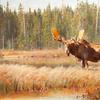Human History for the Holidays, December Natural History Auction to Feature The Ed Francis Collection of Human Artifacts
- LOS ANGELES, California
- /
- November 25, 2009

From the scientific to the superbly decorative, astoundingly unique fossil specimens will be offered by international auctioneers Bonhams & Butterfields on December 6, 2009 in Los Angeles. The 500 lot sale offers a diverse group of high quality and distinctive mineral specimens, gold nuggets, lapidary works of art, gemstones and jewelry as well as exceptional examples of fossils and human history.
Leading the auction is a selection of the human artifacts from the Ed Francis Collection. Known for his discovery of the first Lower Paleolithic hand axe site on the Arabian Peninsula, Mr. Francis' early interest in geology began when, as a farm boy in Southwestern Ohio he was inspired to pursue an education in geology. He attended the School of Mines in both Montana and Colorado and in the early 1950's; Mr. Francis joined a team of oil exploration scientists in the deserts of Arabia and the Sahara. Though he was an amateur untrained in archaeology, Mr. Francis soon discovered a passion for collecting arrowheads and other stone artifacts uncovered during field operations. His surface collecting yielded a superb collection of Middle and Upper Paleolithic, Mesolithic and Neolithic tools and points that were gathered as he explored the central Sahara of Algeria and Niger.
Representing select material from The Ed Francis Collection, the following human artifacts - dating from 240,000 to 5,000 year in age - were collected over several decades by Mr. Francis. Featured items include points, tools, microtools, gouges, celts, blades and hand axes, including two lots of Achuelian hand axes that were among the first Lower Paleolithic Stone Age discoveries from the Arabian Peninsula (estimates range from $400-$4,000).
Also on offer during the holiday auction is a selection of four massive Oregonian Thundereggs (estimates which range from $15,000-125,000). The name, Thundereggs, is derived from a Native American legend which claimed that Thunder Gods living on two of Oregon's highest mountain tops became angry with each other and stole giant eggs from mythical beasts called Thunderbirds to use as weapons against each other. Geologically speaking, Thundereggs are found in areas of prehistoric volcanic activity. The lava from the once active sites cooled and, over millions of years, was buried. The massive and astoundingly unique specimens are highlighted by a gigantic, complete thunderegg, which has been sliced into two halves. The specimen, which is believed to be one of the largest in the world, exceeds four feet in diameter and is entirely made up of multi-colored rhyolitic jaspers (est. $100,000-125,000).
Highlights from a private Northern California Collection will also be offered in December. Specimens of note will include a variety of rare and unique items at various price points, suitable for the well-seasoned collector as well as educational or executive gifts. Among the featured items is "Big Al II," a large research-quality cast of a 26 foot-long Allosaurus (est. $30,000 - 40,000); a fossil fish Phareodus with Mioplosus (est. $1,200-1,500) and a fossil stingray (est. $750-1,000).
Featured among the strong selection of design and decorator items is a collection of very important petrified wood logs and slabs artfully inlayed with ancient fossilized wood (estimates range from $8,000-$150,000); works in quartz, citrine and amber polished to form as well as a diverse selection of framed and unframed fossilized items from the world famous Green River Formation.
Additional highlights will include a brilliant Canadian Ammonite, the natural surface of which is composed of one of only two fossil materials classified as gemstones (est. $25,000-30,000); a unique marine reptile Mosasaur skull (est. $15,000-18,000); a skeleton from one of the earliest known species of cat displaying the characteristic saber-teeth (est. $9,000-11,000); an unusual giant warthog skull (est. 500-700) and a large dinosaur dung specimen (est. $1,800-2,400) as well as several lots of trilobites, the first creatures on Earth that possessed binocular vision (estimates range from $450-4,500).
Preview: December 4-5, Bonhams & Butterfields, Los Angeles
Auction: December 6, 2009, Bonhams & Butterfields, Los Angeles
-End-
Press Contact: Jannelle Grigsby, jannelle.grigsby@bonhams.com, (310) 567-7990
http://www.bonhams.com
About Bonhams
Bonhams, founded in 1793, is one of the world's oldest and largest auctioneers of fine art and antiques. The present company was formed by the merger in November 2001 of Bonhams & Brooks and Phillips Son and Neale UK. In August 2002, the company acquired Butterfields, the principal firm of auctioneers on the West Coast of America and in August 2003, Goodmans, a leading Australian fine art and antiques auctioneer with salerooms in Sydney, joined the Bonhams Group of Companies. Today, Bonhams offers more sales than any of its rivals, through two major salerooms in London: New Bond Street, and Knightsbridge, and a further seven throughout the UK. Sales are also held in San Francisco, Los Angeles, New York and Boston in the USA; and Switzerland, France, Monaco, Australia, Hong Kong and Dubai. Bonhams has a worldwide network of offices and regional representatives in 25 countries offering sales advice and valuation services in 57 specialist areas. For a full listing of upcoming sales, plus details of Bonhams specialist departments, go to www.bonhams.com. (01-08) For other press releases, go to www.bonhams.com/press.




100x100_c.jpg)











